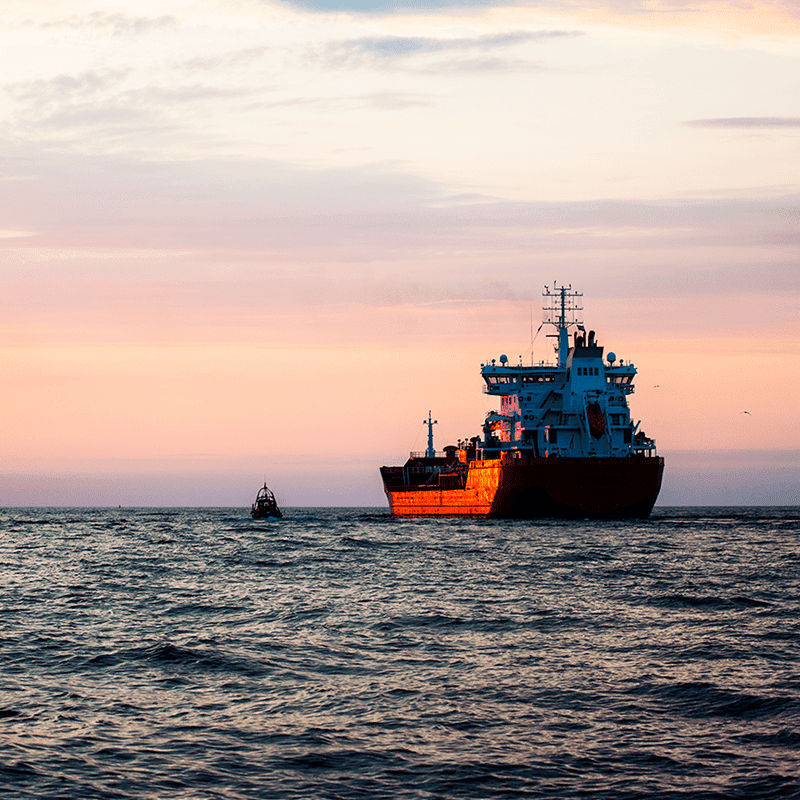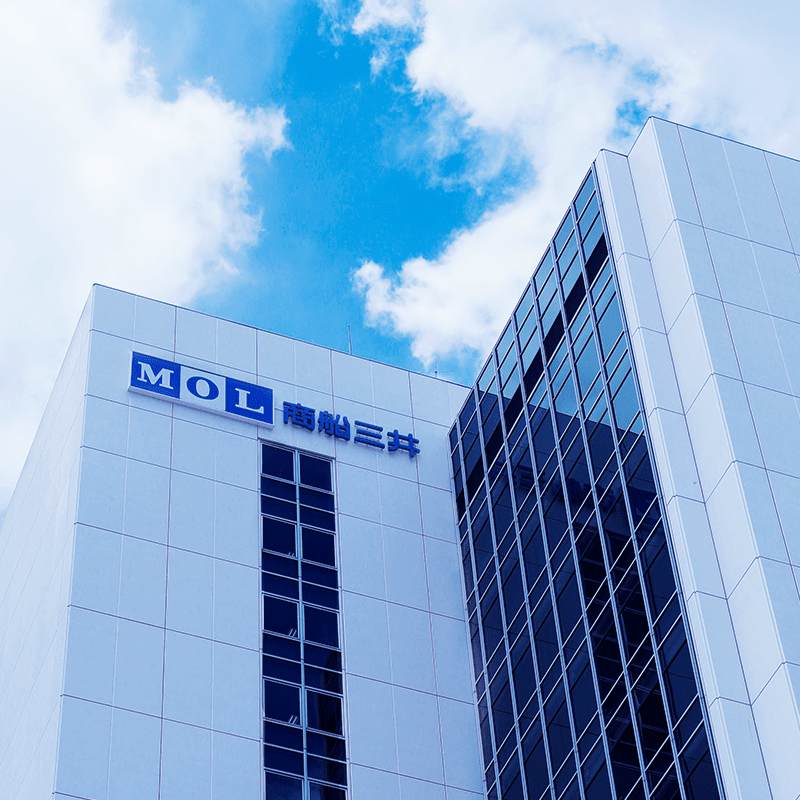BLOG
Welcome to the World of Ships! Special Feature on Various Vessels — Celebrating the Opening of Mitsui O.S.K. Lines’ Interactive Museum “Funeshiru”
- Others
- General Shipping
2025.07.22
Did you know that about 90% of the world's total trade volume is transported by ship? Mitsui O.S.K. Lines Group handles a wide variety of cargo, and today we’d like to introduce the different types of vessels that play key roles depending on what they carry.
In the second half, we’ll also guide you through the new Mitsui O.S.K. Lines Museum “Funeshiru,” opening on July 19. We’ve prepared a special coupon for you, so be sure to read to the end!
Vessels Transporting Energy, Resources, and Products
 Bulkships
Bulkships
Bulkships transport huge volumes of commodities such as iron ore, coal, grain, salt, aluminum, and copper ore without any kind of packaging. Bulkers come in all sizes and configurations, depending on the volume of cargo to be transported and the size of the port of call.
 Tankers
Tankers
Tankers carry liquid cargoes such as crude oil, refined petroleum products, and chemicals. MOL has a full fleet of large crude oil tankers of 200,000 DWT or more, as well as chemical tankers, methanol tankers, and other ships that can accommodate different cargoes. Sometimes, tankers also serve as offshore oil storage depots.
 LNG carriers
LNG carriers
These vessels carry liquefied natural gas (LNG). To transport natural gas, which liquefies at minus 161.5 degrees Celsius, tanks are made of special materials that can withstand ultra-low temperatures, and advanced technology is used to safely load and unload LNG. These ships also use gas that vaporized in the tanks as fuel.
 Car carriers
Car carriers
These vessels load and transport self-propelled cargo such as automobiles and construction equipment. The hull of a car carrier has a multi-tiered deck structure, like multi-level parking lots. Depending on the size of the vessel, they can carry as many as 6,800 automobiles at once.
 Containerships
Containerships
These vessels carry cargo in international standard marine containers※. Containerized cargo can be transferred directly to trucks or railcars for a smooth and speedy transition from sea to land transport.

※The types and sizes of containers, such as refrigerated containers and tank containers, are defined by a common global standard.
Vessels Carrying People and Goods
 Cruise ships
Cruise ships
Cruise ships are not only a means of transportation, but also a fun way to travel. These ships sail through scenic vistas, occasionally slowing down to interact with marine animals, and passengers can enjoy fine dining, watch a show, or just relax and enjoy the ocean on the way to their destination.
 Ferries
Ferries
These versatile vessels carry passengers, passenger cars, trucks, and other cargo vehicles together. They also have private cabins, restaurants, and a public bath with a panoramic view of the sea. A ferry trip can be like a mini-cruise vacation!
 Left: Hotel-like suites
Left: Hotel-like suites
Right: Passengers can enjoy a refreshing public bath with a panoramic view during their trip.
Vessels Play Key Roles in Various Fields
Special vessels do more than just transport things
 Powerships
Powerships
Powerships carry power generation equipment on board and serve as power plants that move around the ocean. Since they can travel virtually anywhere in the world by sea and meet various power needs, powerships are gaining attention as the power supply method of the future. Today, power is often generated using natural gas, which emits less CO2 than heavy oil, and liquefied natural gas (LNG) is sometimes supplied offshore from LNG carriers.
 Cable-laying ships
Cable-laying ships
These vessels lay, repair, and recover optical communication and power cables on the seabed. To lay submarine cables safely and accurately, cable-laying ships feature dynamic positioning system (DPS) to maintain a fixed position despite the motion of waves and wind. These vessels support our digital age, including the stable Internet service you rely on every day.
 FSRUs
FSRUs
A floating storage and regasification unit, or “FSRU” serves as an offshore LNG receiving terminal. It receives, stores, and regasifies LNG. FSRUs serve the same purpose as land-based LNG terminals, but eliminate the costs of construction and can be moved to any location where they are needed.
Vessels Supporting Offshore Wind Power Generation
 SEPs
SEPs
SEP stands for “self-elevating platform,” and in Japanese it is called an offshore wind turbine installation vessel. It can install wind turbines and other equipment necessary for offshore wind power generation. The hull can be raised above the surface of the sea, and the legs can be raised and lowered to allow safe and reliable operation, unaffected by wind and wave action.
 SOVs
SOVs
Service operation vessels, or SOVs, are used to transport technicians to maintain offshore windmills and power plants located far from shore. Technicians may not be able to return to shore immediately depending on the work schedule, so SOVs have rooms where they can stay overnight, a cafeteria to provide meals, and a gym. They also have DPS to absorb hull motions due to waves and wind, allowing them to safely hand off technicians to wind turbines offshore.
 CTVs
CTVs
While SOVs are used for offshore wind farms located far from land, Crew Transfer Vessels (CTVs) are used to dispatch maintenance technicians to wind farms that are relatively close to land. They can pick up and drop off about 12 to 24 technicians from the port where it is based. Fenders are attached to the bow of the vessel and press against the windmill to stabilize the vessel before allowing the technicians leave the CTV and enter the work site.
Vessels Are Essential in a Range of Fields
Vessels Contributing to the Sustainability of the Earth
 Bulk carrier featuring the Wind Challenger sail
Bulk carrier featuring the Wind Challenger sail
The Wind Challenger project was developed to convert wind power, a clean and renewable energy source, into propulsion for vessels. The project aims to bring sailing ships back to life in the modern age, using the latest technology, and to significantly reduce the fuel consumption and greenhouse gas emissions of large cargo ships.
 Liquefied CO2 carrier
Liquefied CO2 carrier
Carbon dioxide capture utilization and storage (CCUS) is attracting attention as a means to achieve a low-carbon, decarbonized society. Liquefied CO2 carriers will play an important role in the carbon-neutral society of the future by transporting captured and liquefied carbon dioxide (CO2) to storage and utilization sites. To flexibly respond to various transport needs, a variety of ship types and dual-purpose carriers that can also transport next-generation clean energy resources are being studied and evaluated.
Source:Learn About the Ocean Shipping Industry! Mitsui O.S.K. Lines, Ltd. (MOL) Job Exploration Book
Set Sail on an Adventure into the World of Ships! “Funeshiru” Opens in Osaka on July 19, 2025!
Up until now, we’ve introduced the ships that support our daily lives. Now, you can “see,” “touch,” and “play” your way through the world of ships at the experiential museum “Mitsui O.S.K. Lines Museum: Funeshiru,” opening Saturday, July 19, 2025, on the 2nd floor of the ITM Building at Asia Pacific Trade Center (ATC)!
“Funeshiru” was born from the desire to help more people discover the world of ships. It originated from a business proposal selected through Mitsui O.S.K. Lines (MOL) Group’s new business initiative launched in 2019. While working in the company’s core transport business, a young employee from one of the group companies felt a strong desire to share the world of ships and the maritime industry with the general public—this passion led to the project’s realization.
We’ve prepared a wide range of content that lets you experience the world of ships—something you can’t learn in school or everyday life. We look forward to welcoming you and your family!
And for those who read to the end—there’s a special coupon waiting for you!
Discover the 3 Highlights of “Funeshiru”!
1. Learn About Maritime Shipping: Feel the Scale of Ships Through Powerful Exhibits!
You’ll enjoy learning about maritime shipping, which supports our daily lives. A must-see is the massive 30-meter-wide immersive theater! Through displays like scale models of active vessels from the MOL Group, you’ll experience the excitement that comes from the sheer scale of ships and the sea.
 The 30-meter-wide panoramic theater and the display of ship models
The 30-meter-wide panoramic theater and the display of ship models
2. Learn About Maritime Jobs: Become a Captain with an Immersive Simulator!
Ever dreamed of piloting a ship? Here, you can try the world’s first 310-degree LED screen ship-handling simulator, offering a vivid and immersive experience! In addition to the ship simulator, you can explore maritime careers like deck officers and engineers through gantry crane simulators, games, models, and illustrated panels.
 The ship-handling simulator surrounded by a 310-degree LED screen
The ship-handling simulator surrounded by a 310-degree LED screen
3. Learn About the MOL Group: Explore the Present and Future of Maritime Shipping!
With over 140 years of history, MOL is the world’s second-largest shipping company by fleet size (as of March 2025). The museum also highlights future-focused initiatives like technology development and environmental efforts. Don’t miss the photo corner, where you can dress in a seafarer’s uniform and take commemorative pictures!
 The uniforms for photo shoots
The uniforms for photo shoots
Enjoy Even More: Café & Shop
・Café : Inspired by a "port" where people and goods from around the world come together, the café serves "ocean-traveled flavors." Enjoy a variety of dishes, including our original curry, as well as drinks and sweets.
• Shop: Take home a piece of what you've learned! Our shop offers a selection of original "Funeshiru" goods, featuring your favorite types of ships and unique maritime-themed souvenirs.

The café and shop areas are free to enter—feel free to stop by!
Our Blog Team Also Attended the Preview Event!
In the 30-meter-wide immersive theater, captivating videos related to maritime transport were shown regularly, providing an immersive experience. The model display of the current Mitsui O.S.K. Lines Group vessels was particularly engaging, as it realistically recreated navigation and loading scenes using video presentations. The interactive exhibit, which was especially popular with children, allowed them to scan their own drawings of ships and watch them come to life on the wall.

Photo Left: The model display of the current MOL Group vessels.
Right: The exhibit where the drawings of ships start moving on the wall.
In the gantry crane simulator, you can use a handheld controller to grab and move containers on the screen. I gave it a try myself, and it felt like playing a UFO catcher—fun even for adults!
The Ship Navigation Simulator, featuring a 310-degree LED screen, was especially impressive. The visuals extend not only in front but also to the sides, creating a realistic experience as if you were actually steering a ship.
In the stormy weather scenario, you can even feel the vibrations while navigating, adding to the immersive experience.

Photo Left: Gantry Crane Simulator
Right: Ship Navigation Simulator
Upon visiting the preview event, I found the interactive exhibits at Funeshiru to be highly engaging and enjoyable for both children and adults.
The shop offers a wide variety of original goods, including snacks, eco-bags, stationery, and keychains—making it worth a visit on its own.
At the café, you can enjoy meals and take a relaxing break while gazing out at the port in a convenient take-out style.
Drinks and soft-serve ice cream inspired by the sea and ships are also highly recommended.
We sincerely look forward to welcoming you. Please come and visit us!
Details of Mitsui O.S.K. Lines Museum “Funeshiru”
%20(1).jpg?width=766&height=1060&name=Funeshiru%20details%20(1)%20(1).jpg)
Shuttle bus service between ATC and the Expo

FUNESHIRU
Official Web Site
Learn about the museum’s concept and exhibits. Discover how “Ships are so fascinating!” through our introduction page.
【Official Instagram Account】

Be sure to check out the official website and Instagram for the latest updates!
In addition, visitors who read this blog will receive a discount on the admission fee! Please present the following discount coupon when you enter the museum.
%20(1).jpg?width=2240&height=1134&name=Admission%20discount%20coupons%20(1)%20(1).jpg)
Recommended Articles
2022.07.05
- General Shipping
2021.04.13
- Energy
2024.02.06
- General Shipping
- Market Analysis
2023.12.19
- General Shipping
2021.08.07
- Eco Friendly
Latest Articles
2025.07.22
- General Shipping
2025.07.22
- Others
- General Shipping
2025.07.07
- Others
- BLOG
- Welcome to the World of Ships! Special Feature on Various Vessels — Celebrating the Opening of Mitsui O.S.K. Lines’ Interactive Museum “Funeshiru”








